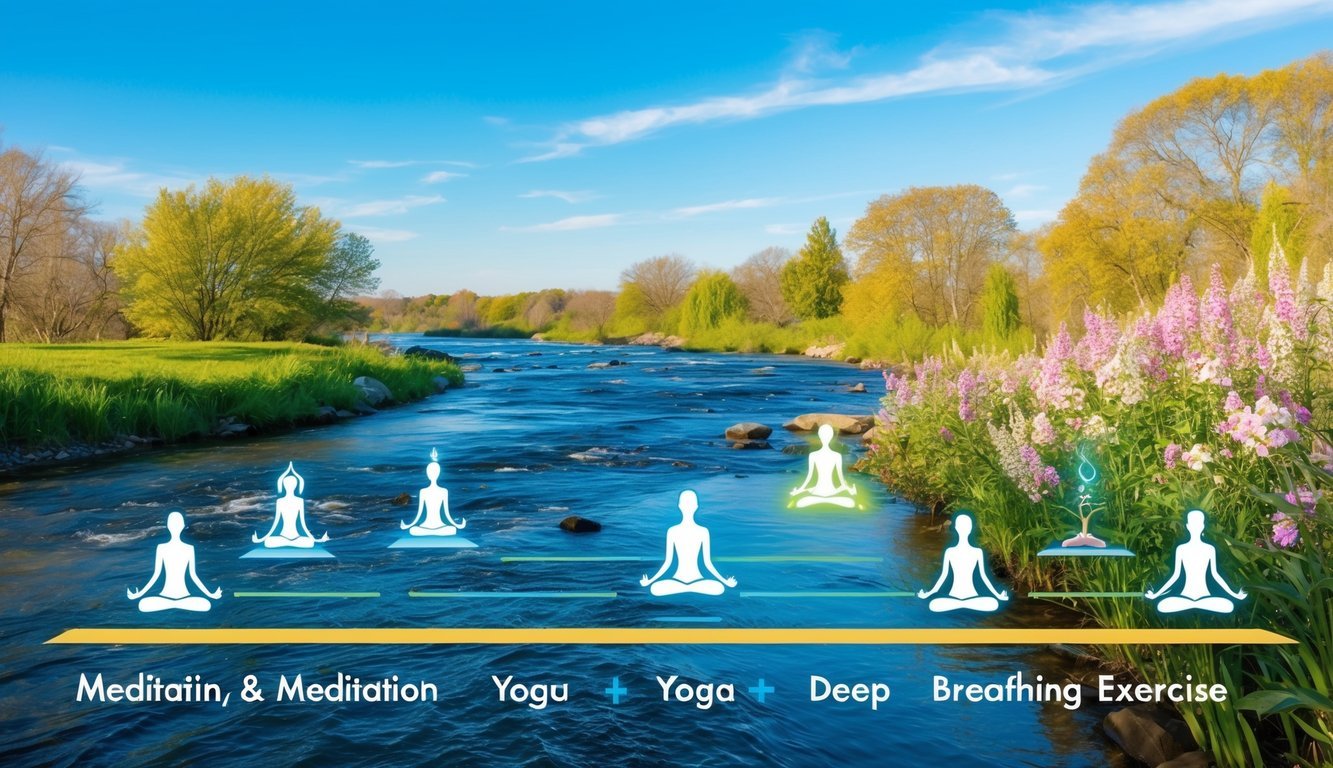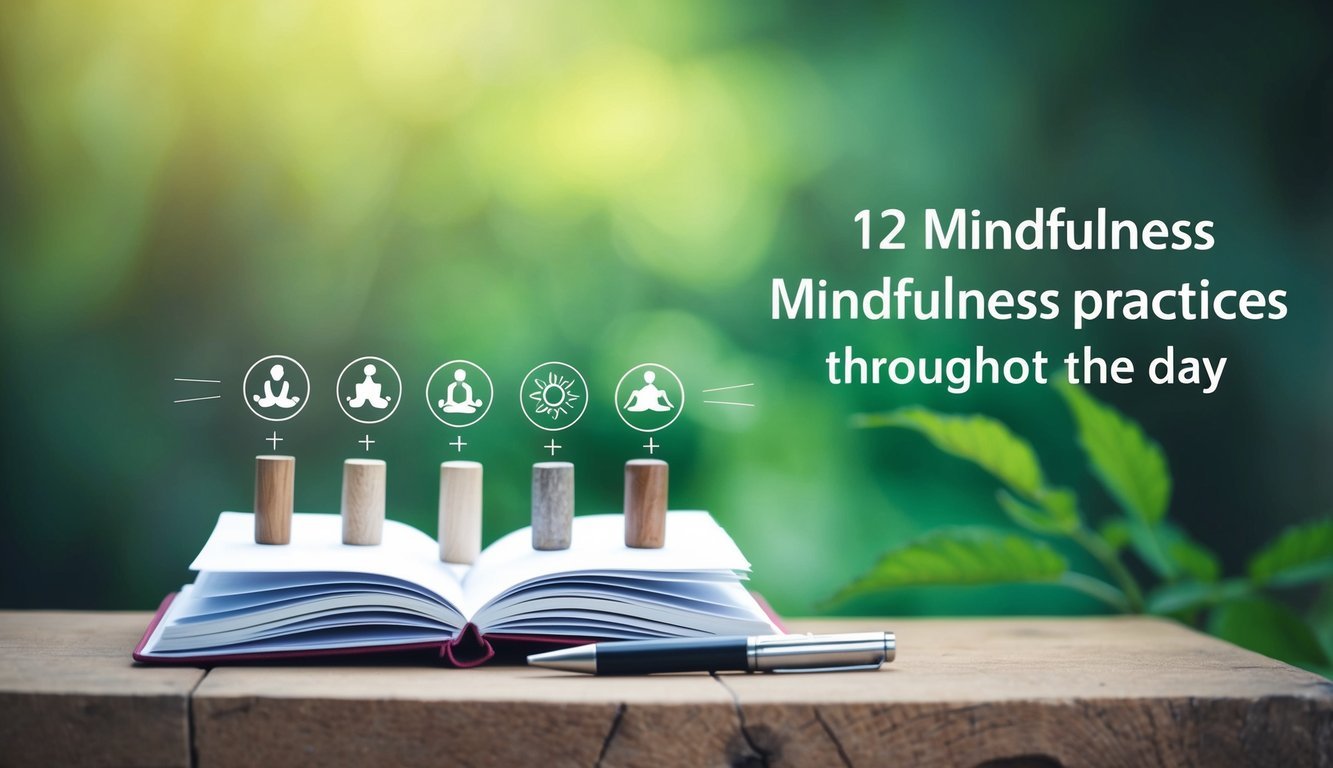PsychNewsDaily Publishers
100 Summit Drive
Burlington, MA, 01803
Telephone: (320) 349-2484
PsychNewsDaily Publishers
100 Summit Drive
Burlington, MA, 01803
Telephone: (320) 349-2484
Mindfulness enhances well-being through techniques like mindful breathing, gratitude practices, and focused listening, promoting emotional balance and reducing stress in daily life.

Many people seek to create a sense of calm and focus in their lives. Mindfulness is one effective way to achieve this. Incorporating simple techniques throughout the day can enhance your well-being and help you maintain a clearer mind.

Practicing mindfulness does not require extensive time or complicated methods. Instead, it can be a part of daily routines and activities, allowing for moments of peace amidst the busyness of life. With a few easy changes, individuals can cultivate a more present and engaged mindset.

Starting the day with mindful breathing can set a positive tone. It helps clear the mind and reduce stress.
To practice, find a comfortable spot to sit or stand. Close your eyes and take a deep breath in through the nose.
Counting to three can help maintain focus on the breath. Next, hold the breath for a moment.
After that, slowly exhale through your mouth. You can do this several times, allowing each breath to bring calm.
In just a few minutes, you can feel more centered and ready for the day. Mindful breathing can improve focus and enhance well-being.
Making it a daily habit can lead to lasting benefits. Simple breaths can create a sense of peace that lasts throughout the day.

Practicing gratitude during meals can make eating more meaningful. Taking a moment before the meal to appreciate it can enhance the experience.
You can start by thinking about where the food comes from. This could include the farmers, the hard work, and the journey the food took to get to your plate.
Before taking the first bite, express thanks for the meal. This could be a silent thought or even saying it out loud.
While eating, focusing on the flavors and textures helps you enjoy the food even more. Engaging all the senses makes meals more satisfying.
Gratitude can also create a positive mood. By appreciating the meal, you can feel less stressed and more present. This simple practice can turn an ordinary meal into a special moment.

Walking breaks can be a great way to practice mindfulness. Stepping outside or even walking around the office allows for a moment to refresh and reset.
During these walks, you can focus on the sights and sounds around you. Noticing the rustle of leaves or the feel of the ground underfoot can enhance the experience.
It helps to take slow, deep breaths while walking. This boosts relaxation and brings attention to the present moment.
You can also pause at times to observe your surroundings. Taking a moment to enjoy what is around can deepen the sense of calm.
Mindful walking does not have to take long. Just a few minutes can help reduce stress and improve mood.
Incorporating these breaks into the day can lead to greater focus when returning to tasks. It is an easy way to boost overall well-being.

Mindful listening means fully focusing on what someone else is saying. It involves giving your complete attention without distractions.
When a person speaks, they often share more than just words. The tone and emotion are important too. By listening carefully, you can better understand their feelings.
Put away phones and other interruptions during conversations. This shows respect and care for the speaker.
To practice mindful listening, take a moment before responding. This pause helps gather thoughts and ensures a thoughtful reply.
Noticing body language also adds to the listening experience. It reveals feelings and needs that might not be spoken.
Engaging in this way can deepen relationships. It creates a safe space where people feel heard and valued.
By practicing mindful listening, you can improve communication skills and build trust with others. It is a simple yet powerful way to connect.

Focusing on one task at a time can improve concentration. When you dedicate your full attention to a single job, you often complete it more efficiently.
To practice this, you can set aside distractions. This might mean turning off the phone or finding a quiet place. By doing so, you create a space where you can concentrate better.
Starting with small tasks can help. For example, focusing on washing dishes instead of multitasking. This allows you to enjoy the task and be aware of the moment.
Mindfulness in daily tasks is beneficial. It encourages a sense of accomplishment and keeps the mind engaged. Focusing fully can turn chores into moments of peace and clarity.

Using an app for guided meditation is a simple way to fit mindfulness into daily life. Many apps provide sessions that range from a few minutes to longer periods, making it easy to find time.
Popular apps like Calm and Headspace offer structured programs for beginners and experienced users alike. They provide guidance on how to meditate and focus on breathing.
These apps can also help you track your progress over time. This feature encourages consistency, which is key for developing a mindfulness practice.
Free options, such as Insight Timer, give users access to numerous guided meditations and courses. With so many resources available, anyone can find something that suits them.
Downloading a meditation app can be a gentle reminder to take breaks throughout the day. Even a few minutes of guided meditation can help clear the mind and reduce stress.

Deep breathing exercises are a simple way to practice mindfulness. They help calm the mind and reduce stress. Just a few minutes can make a difference.
One popular method is the 4-7-8 technique. This involves breathing in for four seconds, holding the breath for seven seconds, and then exhaling for eight seconds. It can be done anywhere and anytime.
Another approach is to simply pay attention to breathing. Inhale deeply through the nose and exhale through the mouth. Focusing on each breath helps bring awareness to the present moment.
Breathing exercises can also be combined with sitting or walking. Being mindful while breathing during movement can create a peaceful experience.
Regular practice can improve focus and emotional well-being. It offers a break in the day, making it easier to handle challenges. Deep breathing is a valuable tool for anyone looking to be more mindful.

Yoga can be a great way to practice mindfulness every day. It encourages focus on the body and breath. This helps calm the mind and reduces stress.
You can start with just a few minutes of yoga each morning. Simple stretches or poses can wake up the body. This sets a positive tone for the day ahead.
Placing a yoga mat in a visible spot can remind you to practice. Even a quick session during breaks can be helpful. It’s okay to do just a few poses to stay connected with the breath.
Many people find that yoga helps them feel more present. By focusing on movements, they block out distractions. This encourages a sense of peace.
Watching online videos or joining a local class can provide guidance. This can make the practice feel more engaging and fun. With regular practice, yoga can become a cherished part of the day.

Taking a moment to appreciate nature can be a great way to practice mindfulness. It helps connect you with the world around you.
When you step outside, you can notice the trees, flowers, or even the sky. Listening to the sounds of birds singing can also bring a sense of peace.
You might choose to sit in a park and feel the breeze on your face. This pause allows you to focus on the present moment.
Watching clouds drift by can spark creativity and relaxation. Each detail, from the colors to the shapes, invites deeper attention.
Appreciating nature doesn’t always require a long time. Even a few deep breaths while noticing surroundings can make a difference.
Making this a regular practice can brighten your day. It can offer new perspectives and help reduce stress.

Keeping a daily gratitude journal can help foster mindfulness. It encourages focusing on positive moments and experiences. Each day, you can jot down things that made you feel thankful.
The practice can be simple. You might write about enjoyable interactions, beautiful weather, or personal achievements. This reflection helps to shift attention away from stress and negativity.
Setting aside a specific time each day for this practice can be helpful. Many find that writing in the morning or before bed works best. Consistency makes it easier to develop this habit.
As you write, you may notice patterns in what you value. The journal allows you to explore your thoughts and feelings more deeply. Over time, this can enhance your overall sense of well-being.
A gratitude journal is not just a record but also a tool for self-discovery. It can be a comforting companion on the journey toward mindfulness.

A body scan is a simple mindfulness practice that can help relax the mind and body. It involves focusing on different parts of the body and noticing any sensations present. This practice is ideal before going to sleep.
To start, find a comfortable position. Lying down is often best. Begin at the toes and slowly move up the body, paying attention to each area. Notice any tension or discomfort without judgment.
As you move through the body, you can take deep breaths. This helps release tension and calm the mind. The goal is to connect with the body and let go of the day’s stress.
Body scan meditation can be done in just a few minutes. This makes it easy to fit into any bedtime routine. Many find that it improves sleep quality and promotes deeper relaxation.

Mindful stretching can be a great way to unwind and connect with the body. It encourages awareness of how muscles feel as they stretch and relax.
When you stretch mindfully, you focus on your breathing. This helps to calm the mind and release tension in the body.
Taking a few moments each day to stretch can improve flexibility and reduce stress. It is important to notice any tight areas and breathe into them.
Simple stretches can be done at home, work, or even outside. They can be part of a morning routine or a break during the day.
Focusing on each movement helps create a sense of peace. Even a few minutes of mindful stretching can make a big difference in how you feel throughout the day.

Mindfulness focuses on being fully present and aware. It encourages individuals to observe their thoughts and feelings without judgment. This practice can lead to greater mental clarity and emotional balance.
Mindfulness is the practice of staying aware in the moment. It involves paying attention to thoughts, feelings, and sensations as they happen. Instead of being lost in thoughts about the past or future, mindfulness invites individuals to experience the present.
This can be practiced in various ways, such as mindful breathing, eating, or even walking. The key is to engage with the moment fully and without distraction. This practice can help clear the mind and reduce stress. It is not about achieving a particular state but about being aware of what is happening right now.
Practicing mindfulness offers numerous benefits. Some key advantages include:
These benefits support mental health and improve daily interactions. Mindfulness can be a simple yet powerful tool for anyone looking to improve their quality of life. By incorporating mindfulness into daily routines, individuals can experience these positive changes over time.

Mindfulness can easily fit into daily activities, enhancing focus and reducing stress. Practicing mindfulness during eating, commuting, and working allows one to remain present throughout the day.
Mindful eating focuses on truly experiencing food. It encourages people to slow down and pay attention to their meals.
This practice helps in appreciating food and can lead to healthier eating habits. It also fosters a better relationship with meals, making dining an enjoyable experience.
Commuting can be a stressful part of the day. Turning this time into a mindful practice can transform the experience.
Mindful commuting promotes calmness and helps reduce stress, making busy travel times more pleasant.
Bringing mindfulness into the workplace can improve focus and productivity.
This approach can lead to maintaining a clearer mind and fostering better work relationships. Being present at work can greatly enhance job satisfaction.
Many people have questions about adding mindfulness to their daily routines. This section addresses common concerns and provides practical tips for incorporating mindfulness into different parts of life.
One effective way is to practice mindful breathing for just a few minutes each morning. This can help clear the mind before starting the day. Taking short breaks to focus on breathing can also create space for mental clarity during busy tasks.
Beginners can try mindful eating by paying full attention to each bite. Another activity is mindful walking, where one focuses on the sensations of their feet touching the ground. These activities do not require much time and can easily fit into the day.
Between tasks, taking a couple of deep breaths can refocus the mind. Another option is to do a quick body scan, where one notices tension and consciously relaxes those areas. These brief exercises can help maintain productivity and focus.
Students can use mindfulness techniques like taking a few minutes to practice gratitude. Writing down three things they are thankful for can improve mood. Stretching or mindful breathing can also refresh the mind before returning to studies.
During a commute, individuals can focus on their breathing while driving or riding. Listening to calming music or guided meditation can create a more mindful atmosphere. These practices help reduce stress and make the commute feel more pleasant.
One simple strategy is to pause and take a deep breath before reacting to a situation. Another strategy is to practice mindful listening when conversing with others, fully engaging without distractions.